Seville’s rich Roman heritage stems from the nearby city of Italica, which played a pivotal role in shaping the region’s history. Founded in 206 BC as one of Hispania’s first Roman settlements, Italica boasted an impressive amphitheater that could seat 25,000 spectators, showcasing the grandeur of Roman architecture. The city’s exquisite mosaics and status as the birthplace of two Roman emperors further highlight its cultural significance. While challenges in funding and preservation efforts continue, exploring Italica’s well-preserved ruins offers a fascinating glimpse into Seville’s captivating Roman past.
Key Points
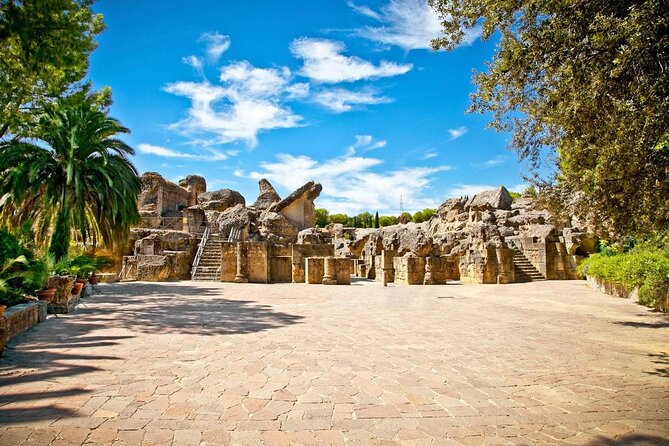
- Italica, located near Seville, was an ancient Roman city and the birthplace of two Roman emperors.
- The well-preserved ruins of Italica, including an impressive amphitheater and intricate mosaics, offer an immersive experience into Seville’s Roman heritage.
- Funding challenges and limited preservation efforts threaten the long-term maintenance and conservation of Italica’s historical structures.
- The private tours of Italica provide an opportunity for visitors to explore the site’s architectural and cultural significance with the guidance of an official guide.
- Despite the ongoing preservation concerns, Italica’s enduring splendor continues to captivate visitors seeking to discover Seville’s ancient Roman past.
Tour Overview and Details
This private tour of Italica, the impressive Roman ruins located just outside of Seville, Spain, offers visitors a chance to enjoy the city’s rich historical past.
With daily departures and half-day visits accompanied by an official guide, travelers can explore the well-preserved mosaics and amphitheater of this former Roman settlement.
The tour includes private transportation in an air-conditioned vehicle, with pickup from your hotel or accommodation in Seville.
Prices start at $136.34, varying by group size, and there’s free cancellation up to 24 hours before the experience.
Confirmation is provided at booking, making this an accessible and convenient way to discover Italica’s Roman legacy.
You can also read our reviews of more tours and experiences in Seville.
Inclusions and Exclusions
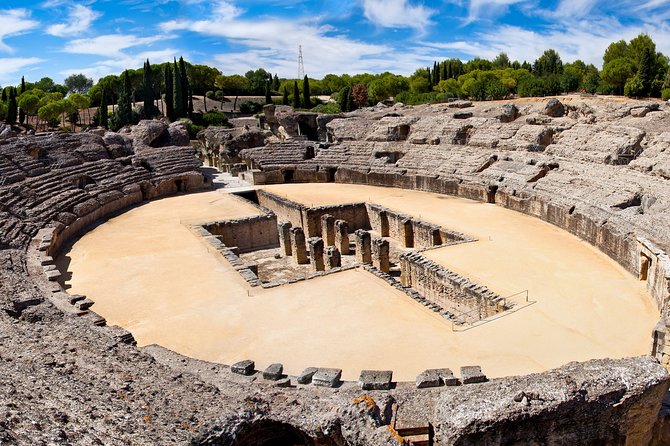
The private tour includes the services of an official guide as well as transportation in an air-conditioned vehicle, with pickup from your hotel or accommodation in Seville. While the tour price covers these essentials, it excludes personal expenses, gratuities, lunch, and any other unspecified services.
| Inclusions | Exclusions |
|---|---|
| Official guide | Personal expenses |
| Private transportation | Gratuities |
| Hotel/accommodation pickup | Lunch |
| Other unspecified services |
This tour provides a comprehensive experience, with the key elements necessary for an engaging and seamless exploration of the historic Italica site.
Accessibility and Participation
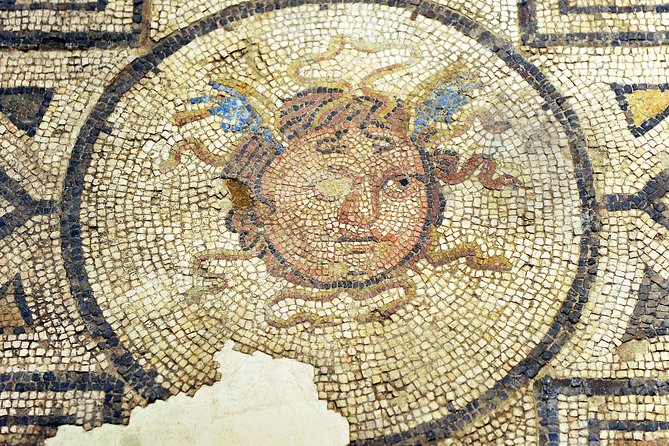
Most travelers can participate in this private tour of Italica, Seville. However, there are a few considerations:
- Infants must sit on laps during the tour and transportation.
- The site is stroller accessible, but not wheelchair accessible due to the uneven terrain.
- This is a private tour, meaning only your group will participate in the activity.
The tour provides an opportunity to explore the well-preserved Roman ruins and mosaics of Italica, offering a unique glimpse into the past.
Whether you’re a history enthusiast or simply seeking a cultural experience, this tour caters to a range of travelers, ensuring an engaging and accessible visit.
Exploring Italica’s Ruins
Visitors to Italica will find themselves immersed in the grandeur of ancient Roman architecture. The well-preserved ruins and mosaics offer a captivating glimpse into the daily lives of Romans. Highlights include the impressive amphitheater, which could seat 25,000 spectators, and the intricate mosaics that adorn the floors of the former homes and baths.
| Feature | Description |
|---|---|
| Amphitheater | Seating capacity of 25,000 |
| Mosaics | Intricate designs adorning floors |
| Preservation | Well-preserved ruins and structures |
| Funding | Concerns raised about limited resources for maintenance |
Despite some funding challenges, Italica remains a must-see destination for history enthusiasts and those seeking to explore the ancient roots of Seville.
Marveling at Preserved Mosaics
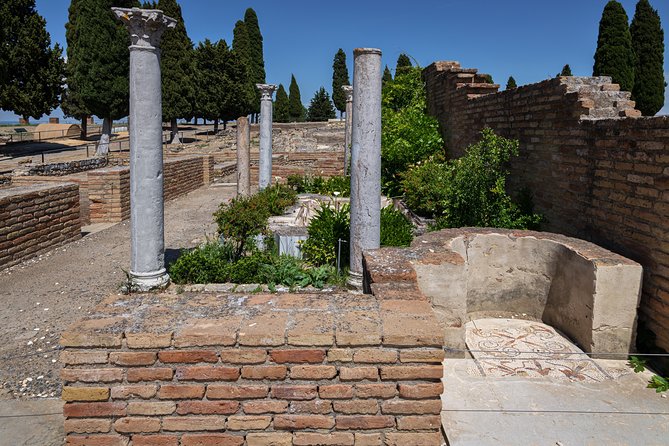
Wandering through the ruins of Italica, one can’t help but be captivated by the intricate mosaics adorning the floors.
These well-preserved artworks offer a glimpse into the opulence of Roman life. Highlights include:
-
The stunning black-and-white mosaic depicting the god Neptune in the House of the Planetarium, showcasing the incredible craftsmanship of the ancient artisans.
-
The colorful mosaics in the public baths, featuring intricate geometric patterns and mythological scenes that dazzle the eye.
-
The impressive mosaic in the amphitheater, which covers a vast expanse and depicts a variety of flora and fauna, providing a fascinating insight into the Roman world.
These mosaics not only impress with their beauty but also serve as tangible reminders of Italica’s rich cultural heritage.
- Alcazar and Cathedral of Seville Tour With Skip the Line Tickets
- Seville Highlights Bike Tour (English)
- White Villages and Ronda Day Tour From Seville
- Sevilla Food Tour: Tapas, Wine, History & Traditions
- Alcazar of Seville Reduced-Group Tour
- Flamenco Show at Tablao El Arenal With Drink and Optional Dinner or Tapas
Amphitheater: Grandeur of Roman Architecture
The amphitheater at Italica stands as a testament to the grandeur of Roman architecture. This massive structure, which could seat up to 25,000 spectators, showcases the engineering prowess and scale of Roman construction. Visitors are awestruck by the amphitheater’s well-preserved state, a testament to the durability of Roman building techniques.
| Amphitheater Features | Details |
|---|---|
| Seating Capacity | 25,000 |
| Construction | Durable Roman Engineering |
| Preservation | Remarkably Well-Preserved |
| Significance | Iconic Roman Architecture |
The amphitheater’s grandeur and significance highlight the cultural and historical importance of Italica, providing a glimpse into the splendor of Roman Seville.
Funding Challenges and Preservation Efforts
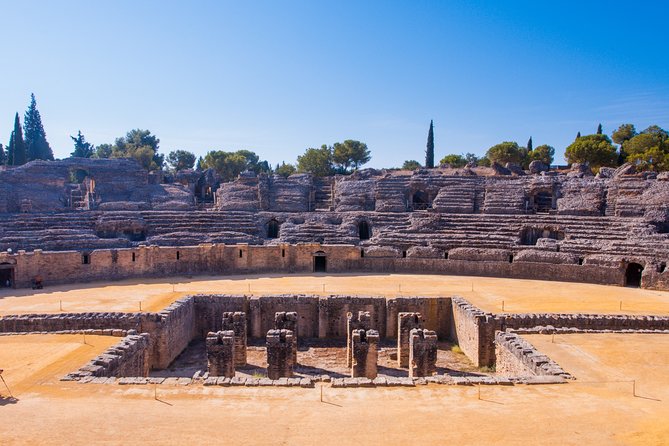
Despite the grandeur and preservation of Italica’s iconic amphitheater, the site faces ongoing funding challenges that threaten its long-term upkeep. Insufficient government support and limited private investment have made it difficult to maintain the ancient Roman ruins and mosaics.
As a result:
- Erosion and weathering are gradually deteriorating the site’s structural integrity.
- Necessary conservation efforts, such as stabilizing foundations and restoring crumbling walls, remain underfunded.
- Visitor amenities like walkways and signage require regular maintenance, which is often lacking due to budget constraints.
Addressing these preservation obstacles will be crucial to ensuring Italica’s historical legacy endures for future generations to experience.
Taking in Seville’s Roman Heritage
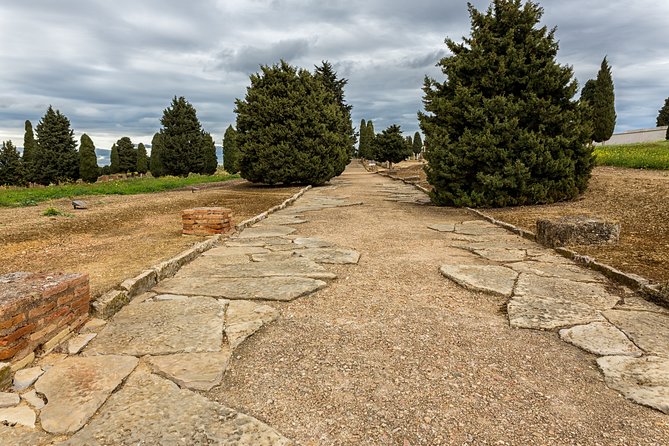
Exploring Italica’s well-preserved ruins and mosaics offers visitors an immersive glimpse into Seville’s illustrious Roman heritage.
The private tour guides lead groups through the impressive amphitheater, highlighting its grand scale and architectural details. Visitors marvel at the intricate mosaics that once decorated palatial villas, providing a window into the daily lives of ancient Romans.
The tour’s intimate setting allows for deeper engagement and understanding of Italica’s significance as the birthplace of two Roman emperors.
Though funding challenges hinder full preservation, the site’s enduring splendor captivates all who experience this unique connection to Seville’s storied past.
Frequently Asked Questions
What Is the Best Time of Year to Visit Italica?
The best time to visit Italica is during the spring or fall when temperatures are mild. Crowds are smaller, and you’ll avoid the scorching summers and chilly winters that can make outdoor exploration less comfortable.
Are There Any Special Events or Festivals Held at Italica?
There are no regularly scheduled special events or festivals held at Italica. The archaeological site is open year-round for visitors to explore the well-preserved Roman ruins and impressive amphitheater independently or as part of a guided tour.
Can Visitors Explore the Underground Tunnels at Italica?
Visitors can explore the underground tunnels at Italica, which were used by Roman gladiators and actors. Access is limited, so visitors should check with their guide about availability and safety requirements during the tour.
What Is the Dress Code for Visiting Italica?
There’s no strict dress code for visiting Italica, but comfortable, weather-appropriate clothing is recommended. Visitors should wear sturdy shoes as the site has uneven terrain. Bringing a hat and sunscreen is also advisable on sunny days.
Are There Any Nearby Roman Sites to Visit in Addition to Italica?
While Italica is the main Roman site near Seville, visitors can also explore other nearby Roman ruins like Carmona, which features an amphitheater, necropolis, and well-preserved walls and gates from the era.
The Sum Up
Seville’s Roman heritage is showcased through the impressive ruins of Italica, where visitors can marvel at the grandeur of Roman engineering and architecture. The well-preserved mosaics and the majestic amphitheater offer a glimpse into the opulent Roman lifestyle. Despite funding challenges, ongoing preservation efforts ensure that this historic site continues to captivate and educate travelers about Seville’s significant role in the Roman Empire.
More Tour Reviews in Seville
Not for you? Here's more things to do in Seville we have recnetly reviewed
- 3 Best Canoe And Kayak Experiences In Seville
- 12 Best 2 Day Tours In Seville
- 25 Best Canoe And Kayak Experiences In Seville
- 25 Best Cruises And Boat Tours In Seville
- 13 Best Food Tours In Seville
- 12 Best Full-Day Tours In Seville
- 15 Best Photography Experiences In Seville
- 13 Best Dining Experiences In Seville
- 13 Best Dinner Tours In Seville
- 7 Best Lunch Experiences In Seville
- Horse-Drawn Carriage Private Ride Through Seville
- Caminito Del Rey. 1 Day Excursion.
